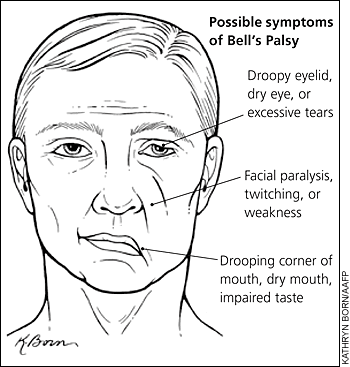
Am Fam Physician. 2007;76(7):1004
See related article on Bell's palsy.
What is Bell's palsy?
Bell's palsy is a paralysis of the muscles on one side of the face. It usually develops over one to three days, and then slowly improves or completely goes away in one to three months. Most people with Bell's palsy recover, but some are left with weakness on one side of the face. It is most common in adults in their 40s, but it can occur at any age.
What causes Bell's palsy?
It is caused by swelling of the facial nerve. The facial nerve controls muscles on the side of the face, the flow of tears, and the ability to taste. There are two facial nerves, one for each side. Bell's palsy only affects one facial nerve. The exact cause of the swelling is not known, but some doctors think that herpes simplex virus type 1 (the same virus that causes cold sores) may play a role. Other diseases can affect the facial nerve, but these diseases usually have other symptoms that don't occur with Bell's palsy.
How is Bell's palsy treated?
Treatment usually includes steroid pills (such as prednisone) and an antiviral drug; you will usually take these for one to two weeks. If you start taking medicines within three days of the start of your symptoms, the chances of complete recovery are better.

Where do I get more information?
Talk to your doctor. If you develop symptoms of Bell's palsy, you should see your doctor as soon as possible. Treatment works best when it is started early, and your doctor may also want to test for other diseases that cause facial nerve problems.
The National Institutes of Health Web site has information about Bell's palsy athttp://www.ninds.nih.gov/disorders/bells/bells.htm.